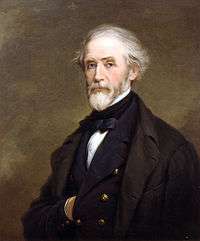Dennis Hart Mahan

Dennis Hart Mahan [məˈhæn][1] (April 2, 1802 – September 16, 1871) was a noted American military theorist and professor at the United States Military Academy at West Point from 1824-1871. He was the father of American naval historian and theorist Rear Admiral Alfred Thayer Mahan. Of his other four children, his son Frederick August Mahan also graduated from West Point in 1867.[2]
Biography
Dennis Hart Mahan was the child of Irish Catholic immigrants. He was baptized at New York City, though like other immigrant children of that era, e.g., General Philip Sheridan, it is unclear whether Mahan was born at New York or in Ireland. Mahan graduated from West Point in 1824, first in his class. Such was his acumen that in his third year he was appointed acting assistant professor of mathematics. After graduation, he started teaching at the Military Academy with the very next class of cadets (1824). In 1826, he] was sent to Europe to study advanced engineering techniques and military institutions.[3] Upon returning to West Point in 1830, he was promoted to Professor of Civil and Military Engineering. He resigned his commission in 1832 to accept the position of Chair of the Engineering Department.
An important influence on the military conduct of the American Civil War and Civil Engineering, Mahan is best understood as an educator and technology transfer agent, not a theorist. Mahan almost singlehandedly compiled and transferred the best of European engineering to the United States and other English-speaking parts of the world. Virtually all 19th century American engineering schools were started with West Point-educated faculty or adopted its texts.
As a professor of military science at West Point, in addition to engineering methodology, Mahan promoted the development of professionalism and wrote extensively on fixed fortifications, field fortifications, strategy and tactics. His books on military thought were widely influential.[4] His writings became standard textbooks in the worldwide field from the time they were written until after World War I. Mahan also founded the Napoleon Seminar at West Point, where advanced under-graduates and senior officers including Lee, Reynolds, Thomas and McClellan, studied and discussed the great European wars, Napoleon and Frederick the Great.
Professor Mahan's lectures and writings about military fortifications and strategy were instrumental in the conduct of the Civil War by the officers on both sides. Most of the Civil War commanders, whether Union or Confederate, learned about entrenchment, fortifications, and how to conduct warfare in the classes that he taught at West Point, and from his pre-Civil War writings. Fort Mahan was one of the Civil War Defenses of Washington.
While the influence of Mahan and West Point on the Civil War remains controversial and neglected, it is not difficult to find many of the Civil War's tactics and strategies presaged in Mahan's work. Topography and the use of terrain to advantage became important thanks to Mahan, as well as the principles of concentration, "celerity" and calculated risk. Lee used the Blue Ridge Mountains to screen his invasions of Pennsylvania and Maryland. Grant used rivers to screen his approaches to Vicksburg and Richmond. The French called this envelopment strategy "la manoeuvre sur les derrières." At Vicksburg, after the envelopment, Grant used a strategy of the central position to defeat his opponent in detail, a Napoleon tactic well-known to Mahan's admirer and Grant's lieutenant WT Sherman, if not Grant himself. At Gettysburg, Reynolds saw the opportunity for a Corps d'Armee engagement where his leading Corps held off Confederate attacks while the mass of the Union army concentrated. The Union's disposition on Cemetery Ridge at Gettysburg is almost perfectly sited according to Mahan's recommendations in "Field Fortifications" for disrupting an opponent's artillery fire. Meade's inability to trap Lee after Gettysburg certainly had something to do with Lee heeding Mahan's advice on planning for a protected line of retreat. Perhaps the Union and Confederate armies would have adopted flexible and resilient division and corps formations in any event, but some credit for the adoption of these extremely important military formations belongs to West Point and Mahan and their contribution to the professional development of most of the Civil War's important officers.
On 16 September 1871, after the West Point Board of Visitors recommended he be forced to retire from teaching, Mahan committed suicide by leaping into the paddlewheel of a steamboat on the Hudson River.[5]
Mahan Hall at the United States Military Academy at West Point was named in his honor. Built in 1971, it houses the Academy's Departments of Civil & Mechanical Engineering (CME) and Systems Engineering. Mahan Hall at the U.S. Naval Academy and the Naval War College were named for his son, Alfred Thayer Mahan.
Books by Dennis Hart Mahan
- Treatise on Field Fortifications (1836)
- Elementary Course of Civil Engineering (1837; revised 1868)
- Elementary Treatise on Advanced Guard, Outposts, and Detachment Service of Troops (1847; revised, 1862)
- Summary on the Cause of Permanent Fortifications and of the Attack and Defense of Permanent Works (1850)
- Elementary Treatise on Industrial Drawing (1853)
- Editor, with additions, the American edition of Mosely's Mechanical Principles of Engineering and Architecture (1856)
- Descriptive Geometry, as applied to the Drawing of Fortifications and Stereometry (1864)
- An Elementary Course on Military Engineering [covering] Field Fortifications, Military Mining, and Siege Operations (1865)
- Permanent Fortifications (1867)
References
- ↑ "Mahan, Alfred Thayer", in The Columbia-Viking Desk Encyclopedia (1953), New York: Viking.
- ↑ Smithsonian: West Point in the Making of America: Dennis Hart Mahan
- ↑ Dennis Hart Mahan, Columbia Encyclopedia, Sixth Edition, 2001-2007
- ↑ Books by Dennis Hart Mahan: Field Fortifications (1836), Summary on the Cause of Permanent Fortifications and of the Attack and Defense of Permanent Works (1850), and An Elementary Course of Military Engineering (2 vol., 1866–67), Advanced Guard and Outpost (1847)
- ↑ Allan R. Millett; Peter Maslowski (1994). For the Common Defense: A Military History of the United States of America. The Free Press. pp. 132–133.